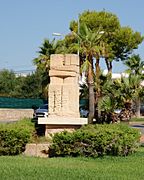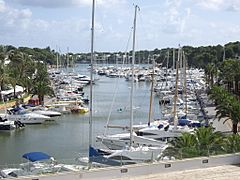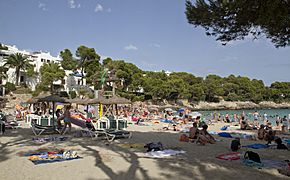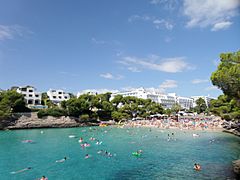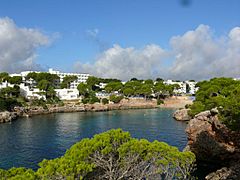Cala d'Or facts for kids
Quick facts for kids
Cala d'Or
|
|
|---|---|
|
Cala d'Or centre
|
|
| Country | Spain |
| Autonomous community | Balearic Islands |
| Province | Balearic Islands |
| Comarca | Migjorn |
| Judicial district | Manacor |
| Municipality | Santanyí |
| Elevation | 62 m (203 ft) |
| Population
(2013)
|
|
| • Total | 3,823 |
| Demonym(s) | Caladoreño |
Cala d'Or is a lovely village located on the eastern coast of Mallorca, a beautiful island in Spain. It's part of the Santanyí area in the Balearic Islands. This popular spot is known for its pretty bays and golden beaches.
Contents
Exploring Cala d'Or
Cala d'Or is part of the Santanyí region, which is a bit further inland. The main city, Palma, and its airport are about 60 kilometers (37 miles) away.
The village of Cala d'Or is spread out along the southeastern coast. It has three main parts: Cala d'Or (the center), Cala Egos (to the west), and Cala Ferrera (to the east). The eastern part of Cala Ferrera actually belongs to the nearby town of Felanitx.
The coastline here is rugged, but it has many beautiful sandy bays. Some of the most famous beaches include:
- Cala Esmeralda (meaning 'emerald green')
- Cala Gran (meaning 'big')
- Cala d'Or (the main bay, also called Caló de ses Dones)
- Cala Llonga (meaning 'long', also called Cala d'es Forti)
- Cala Egos
- Cala Galera
- Caló des Llamp
- Cala Ferrera
- Cala Serena
The nearby village of Portopetro is just a short bus or car ride away, about five to ten minutes.
A Look at History
Cala d'Or has an interesting history, especially when it comes to protecting its shores.
Es Forti: The Old Fort
The Es Forti fort was built in 1740. It was later rebuilt in 1793 after an earthquake damaged it. This fort was very important for protecting the coast from pirates. Today, it's a historical site you can visit in Cala d'Or.
The fort has four sides, each 26 meters long. The sides facing the sea had openings for cannons to fire at enemy ships. The sides facing the land had small holes for soldiers to shoot through and defend against attackers. The fort used to have four cannons and 19 soldiers.
How Cala d'Or Began
In 1932, an artist and architect named Josep Costa Ferrer from Ibiza had a vision. He wanted to create a modern place for tourists and vacations. He first named the new village after Cala d'Hort in Ibiza. However, people from Mallorca changed the name to Cala d'Or, which means 'Golden Bay'.
Village Life and the Marina
The heart of Cala d'Or is along Avenida Boulevard d'Or. You'll find many shops, restaurants, and bars here. Other lively areas are in Cala Ferrera and Cala Egos, also filled with places to eat and shop.
Most buildings in Cala d'Or are painted white. This is a traditional Mediterranean style. Many holiday villas are on the edges of the village, while hotels and apartments are closer to the coast. The buildings are usually small and cube-shaped, inspired by the Ibizan style. This was planned by Josep Costa Ferrer, who wanted the village to look like his homeland.
The Santa María del Mar Church was built in 1956. It also follows the charming Ibizan style.
Cala d'Or is very lively during the summer. But it's not as crowded as some of the bigger resorts in Mallorca. The pedestrian areas are great for exploring shops, bars, and restaurants. You can find both local and international food here.
The Marina
The marina is located in Cala Llonga, a large bay. It has space for 563 boats and covers a huge area of 30,000 square meters. The marina is popular all year round for yachts and chartered boats. It offers excellent protection from storms. You can also find some fancy restaurants and bars around the marina.
Cala d'Or is a favorite place for families and couples from all over Europe. It was one of the first big tourist resorts in Mallorca. The buildings were designed to be small, pretty, white-washed villas, apartments, and hotels, all sticking to the Ibizan theme.
Over the years, Cala d'Or has grown. More and more tourists come to enjoy the fine dining and quiet areas near the beautiful Mondragó natural park. Many hotels offer all-inclusive holidays, but you can also rent luxurious villas and apartments. Most visitors to Cala d'Or come from Western Europe, like Germany, Britain, and France.
Getting Around
Getting around Cala d'Or is easy thanks to its many traffic circles. These circles are often decorated with sculptures or plants.
A fun mini-train runs regularly between the different coves and beaches. This connects all parts of Cala d'Or, making it easy to explore.
The Red Bus, run by TIB, also connects Cala d'Or to other nearby villages and towns.
Gallery
-
Traffic circle 2, featuring a sculpture called Kiss, inspired by Constantin Brâncuși.
Bays and Beaches in the Village
- Cala d'Or
- Cala Gran
- Cala Esmeralda
- Caló d'es Pou
- Cala Egos
- Cala Ferrera (in Felanitx)
- Cala Serena (in Felanitx)
Nearby Natural Beauty
Parc Natural de Mondragó
Just southwest of Cala d'Or and Portopetro, about 5 kilometers (3 miles) away, is the beautiful Parc Natural de Mondragó. This nature preserve is home to two stunning beaches:
- S'Amarador
- Ses Fonts de n'Alís
Both beaches are located in Cala Mondragó within this amazing natural park. It's a great place to explore nature and enjoy the quiet surroundings.
See also
 In Spanish: Cala d'Or para niños
In Spanish: Cala d'Or para niños






